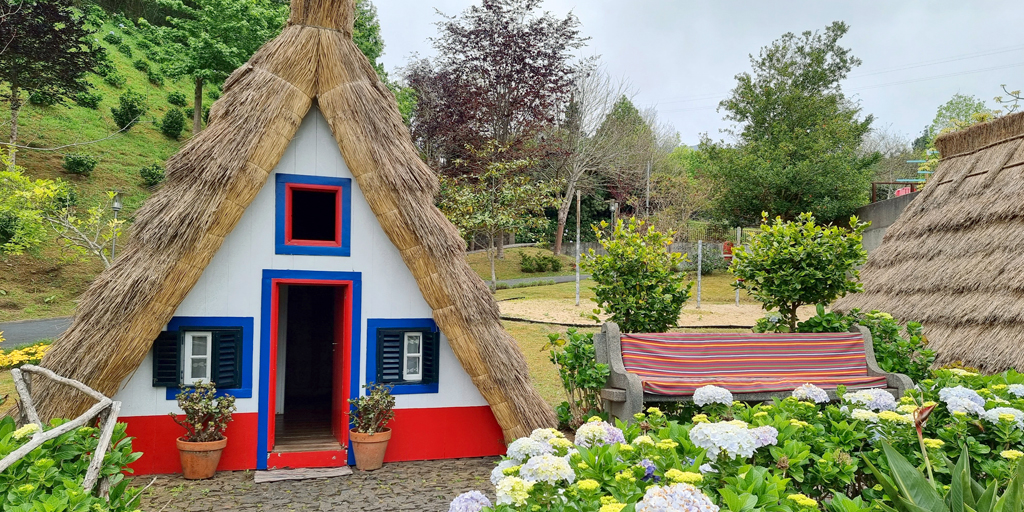
Santana – The history
The rediscoverer of Madeira, João Gonçalves Zarco, first colonized the island in 1419. At the beginning of colonization, the land was divided between nobles and some commoners. In order to farm, the land had to be cleared. This is also the origin of the well-known statement that the island burned for 7 years …
The parish of Santana was finally established as the main town by royal decree on June 4, 1552. The town is named after its patron saint, Santa Ana, in whose honor a church was built in 1689. In 1835, the independent district of Santana was established and the town was given the status of a small town (vila). Santana was granted city status on January 1, 2001.
The region around Santana is characterized by agriculture. Fruit, vegetables and corn are grown here due to the fertile soil and frequent rainfall. Craftsmanship, such as filigree embroidery, is also an important part of the culture and is offered in local stores.
The CASAS DE COLMO
Santana is famous for its traditional thatched farmhouses, the CASAS DE COLMO, which are also a symbol of Madeira Island. Farmers used to live in these simply furnished, often red-painted houses. Today, most of the casas are empty and are only maintained as tourist attractions. The thatched roofs have to be replaced every four to five years.
Their construction is based on the use of regionally available materials and traditional building techniques. The thatched houses were built as low-cost housing solutions, especially for agricultural workers. The roofs were made of thatch (colmo), which was obtained from wheat and rye. Willows, wood and thin sticks were used to stabilize the houses. This construction method was robust and easily adaptable to the climatic conditions of the region.
In the early years of Madeira’s settlement, this construction method was widespread throughout the island. Although the roof is made exclusively of natural materials, the steep slope ensures that rainwater runs off and does not penetrate. In this way, the roofs remain watertight and the room temperatures inside remain mild – in Summer and Winter.
There are three types of construction: gabled or wired houses, kerb houses and hip houses. Gabled houses are those in which the longitudinal beams rest directly on the ground. The kerb houses are a further development of their predecessors and enable better use of space, as the gabled roof ends around 60 cm above the ground, while the roof of the gable houses ends close to the ground. Hipped houses are often referred to as round houses due to the appearance of their roof and were mainly built in the municipality of São Jorge.
Agricultural products such as seeds were stored in the attic; the living area was located on the first floor, which was divided in two by a partition wall. The living area was mainly used as a bedroom, parents‘ bedroom and children’s room. Sometimes the children’s rooms were separated by a fabric curtain to separate the boys from the girls. The attic could be accessed both from the inside (through a trap door) and from the outside (through the attic door) with the help of a ladder. The kitchen was a separate building, also with a thatched roof, where other work was carried out in addition to preparing food, such as embroidery, sewing clothes, spinning and other work related to farming and household chores.
Depending on the slope of the land, some houses also have a cellar, which was used as a storage room or bedroom. In the Madeira Theme Park, you can visit such a “residential complex” with a house and outbuildings and reconstructed scenarios.
Santana as a UNESCO biosphere reserve
Since 2011, the district of Santana has been listed by UNESCO as a biosphere reserve. This is intended to promote the preservation of biodiversity and cultural heritage, as well as sustainable economic development and environmental education.
A biosphere garden has been created in the center of Santana as a constant reminder of Santana’s designation as a UNESCO biosphere reserve. This garden consists of some characteristic elements of the landscape and culture of the municipality: a typical thatched house, a levada and a statue commemorating the biosphere.
The latter was created by Madeiran sculptor Luís Paixão and is intended to represent the planet Earth in its spherical shape in symbiosis with nature, life and the landscape of the female figure. The basis of all the sculptures is the element of water, the source of life.
Conclusion:
Santana combines tradition and modernity: While people used to live mainly from agriculture and crafts, tourism now plays a central role.


